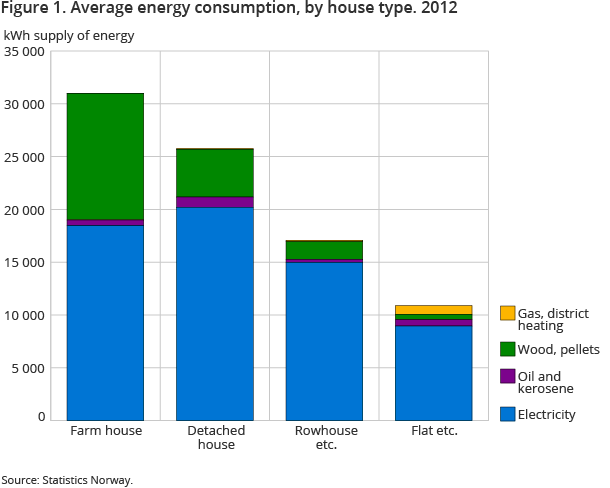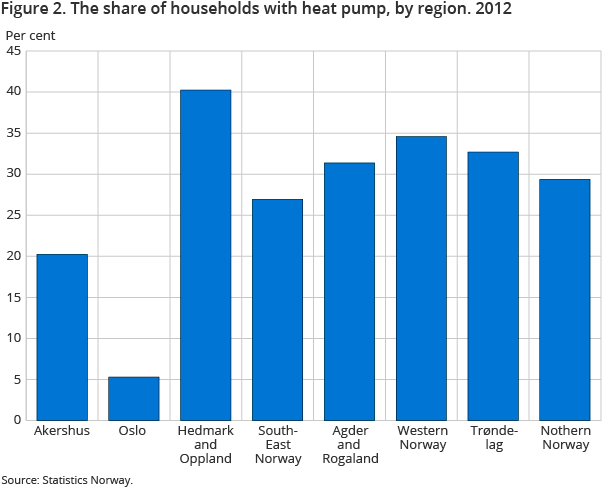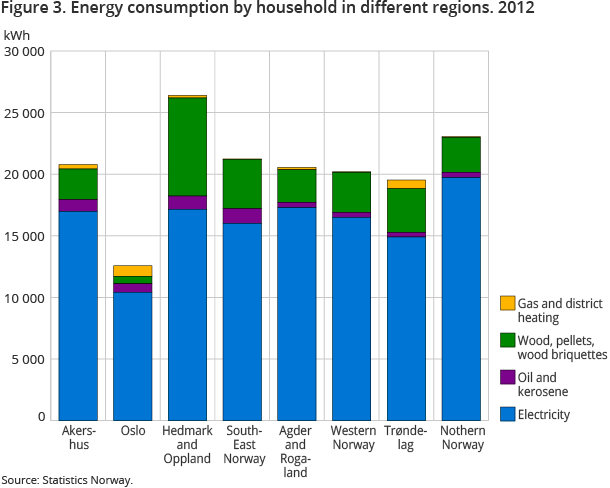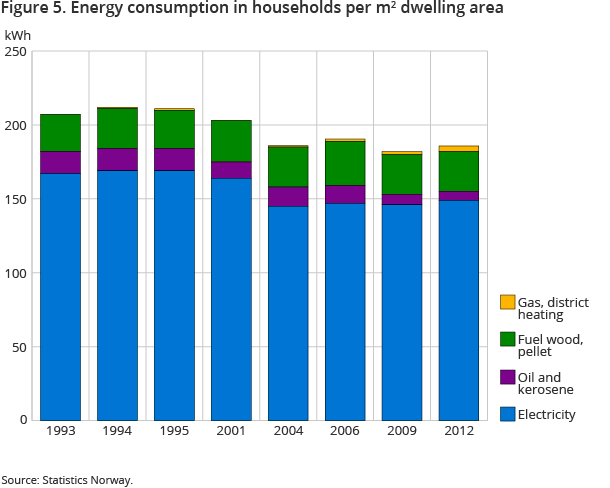Content
Published:
Large increase in the use of heat pumps
In 2012, 27 per cent of all households had a heat pump, which is 9 percentage points more than in 2009. In particular, it is households in detached houses and farmhouses that invest in a heat pump. The survey also shows a downward trend in energy use per household.
| Total energy consumption (kWh) | Total energy consumption (kWh) | Change in per cent | |
|---|---|---|---|
| 2009 | 2012 | ||
| All energ commodities | 20 415 | 20 230 | -0.9 |
| Electrisity | 15 977 | 16 044 | 0.4 |
| Oil and kerosene | 845 | 698 | -17.4 |
| Wood, coal and coke | 3 407 | 3 204 | -6.0 |
| Specific energy consumption (kWh per m2 dwelling area) | Specific energy consumption (kWh per m2 dwelling area) | Change in per cent | |
| All energ commodities | 181 | 185 | 2.2 |
| Electrisity | 146 | 149 | 2.1 |
| Oil and kerosene | 7 | 6 | -14.3 |
| Wood, coal and coke | 27 | 27 | 0.0 |





About 44 per cent of all detached houses had a heat pump in 2012, which is 11 percentage points more than in 2009.
Large variations regionally and between house types
There are large regional differences in energy use and also in the distribution of heat pumps. While only 5 per cent of households in Oslo had a heat pump, the corresponding figure for Hedmark/Oppland is 40 per cent. This reflects the different composition of the housing stock. While there is a predominance of small flats in Oslo, there is a far larger share of large detached houses in Hedmark and also in many other regions in the country.
Detached houses are the most energy-intensive house type, with an average energy consumption that is more than twice that for apartment buildings. This is due to a larger dwelling area, more exterior walls and, often, more household members than in an apartment. Thus, it is more profitable to use a heat pump in a detached house than in an apartment building. Hedmark and Oppland is also the region with the greatest average energy consumption in Norway, which is related to the high share of detached houses and because it is a cold region. While households in Oslo had an average energy consumption of about 12 600 kWh in 2012, the energy use was more than twice that in Hedmark/Oppland, with 26 400 kWh.
Some energy saving with heat pumps
Houses with a heat pump use slightly less energy than similar homes without a heat pump. For households with a living area of more than 150 m 2 , energy consumption is on average 3 900 kWh lower for the households with a heat pump. For villas between 100 and 150 m 2 , the difference is around 1 900 kWh. There is not much difference in electricity consumption, but households with a heat pump use rather less wood and oil.
Since air-air heat pumps are driven by electricity, the power consumption is not necessarily reduced, unless the household only used electricity before the purchase of the heat pump. Besides, there are many who use the heat pump for cooling in the summer, which could push up electricity consumption.
Downward trend in energy consumption
Average energy consumption per household in 2012 was 20 230 kWh. Of this, electricity made up approximately 16 000 kWh. Our second most important energy source is fuel wood, which amounted to around 3 200 kWh per household. The use of oil has dropped sharply downward, and was around 700 kWh in 2012. This is half of the oil consumption level in 2006. The total average energy consumption in 2012 was somewhat lower than in the last corresponding survey in 2009, despite the fact that it was somewhat warmer in 2009 than in 2012. In 2012, the temperature was 0.4 per cent above the normal temperature for the period 1961-1990 , while in 2009, it was one degree above the normal climate. Energy consumption per household has had a declining trend since the 1990s, both in total per household and per square metre of floor space.
More energy efficient buildings
One reason why energy use has been reduced in recent years is that there has been a milder climate. However, in 2010, it was colder than normal for the first time in many years, and then the household energy consumption reached a peak. For the other years, it has been warmer than normal. Furthermore, Norwegian electricity prices have reached the average European level, with NOK 0.8-1 per kWh of electricity, while Norway previously had one of the lowest electricity rates in Europe.
According to the survey, 36 per cent of households said that they have taken steps to reduce energy consumption, and of these, around 80 per cent said that an important reason for their effort was to reduce energy costs. Around 40 per cent said that they had added more insulation to their dwelling, while 61 per cent say they have changed to windows that insulate better. In addition, there are also higher insulation requirements in new dwellings, which has contributed to a decrease in specific energy consumption . While the specific energy consumption is approximately 200 kWh/m 2 in dwellings built before 1954, it has dropped to 172 kWh/m2 for dwellings built after 1997. A small proportion (1.6 per cent) also said they have low-energy or passive houses . The increase in heat pumps can also be assumed to have had some effect on the levelling out of household energy use.
Electric heating is important
Norway remains one of the few countries where electricity is the main heating source. The main heating source for about 73 per cent of the households is based on electricity, either by electric space heaters (48 per cent), electric floor heating (7 per cent), air-air heat pumps (21 per cent) or central heating with electricity. Twelve per cent said that fuel wood was their main source for heating. It is especially farming houses that use fuel wood. About half of the farmers said that they use fuel wood as their main heating source and their average wood consumption is around 11-12 000 kWh per year.
Contact
-
Ann Christin Bøeng
E-mail: ann.christin.boeng@ssb.no
tel.: (+47) 40 81 13 58
